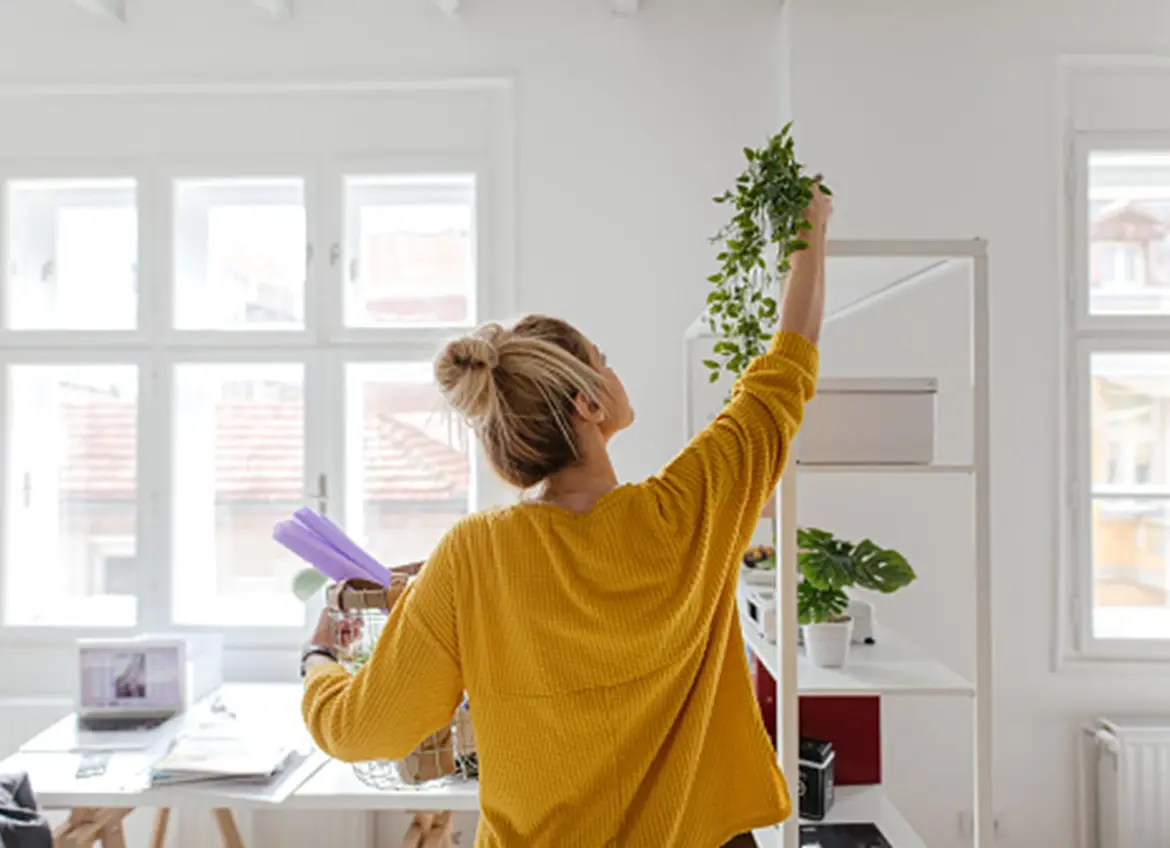
There are more benefits to organizing your home than you might think. These practical techniques can help reduce stress—and win the war against clutter.
We all know that organization can improve the look of your home, but you may be surprised to learn that it can also improve your mental health.
Like a calming spa, a clean and organized home can diminish stress and anxiety, increase your focus, and help improve your mood. Here are the top 10 tips we recommend to get a handle on the mess:
1. Plan ahead
Some projects need serious planning and others don’t. But if you dive right into a project that you should have pre-planned, you may only make a bigger, more frustrating mess. Planning might include researching ideas, taking measurements, or buying items such as shelves, bins, or hooks.
2. Take on one area at a time
Organizing your entire home is a huge effort, so start with one area that you have a clear plan for. Pro tip: Choose an easy project first, such as organizing your linen closet. After you finish that, you’ll be more confident in tackling the next one.
3. Set your budget
Organization can cost you money, so make a budget before you start. Figure out how much you’re willing to spend and stick to your budget when you shop for materials—items like shelving, bins, hooks, or labels can add up quickly. Keep your receipts so you can return items that don’t work in your space.
4. Allow plenty of time
Rome wasn’t built in a day—and you probably can’t organize your entire home in a day. If you’re setting a deadline for your project, keep in mind the scope of the work involved. Organizing your medicine cabinet may only take 30 minutes, but organizing your garage could take days.
After you’ve organized your space, give yourself plenty of time to figure out what works and what doesn’t. Don’t stress if organized areas need adjustments. If you’ve figured out what doesn’t work, you’re one step closer to figuring out what does.
5. Pick a solution you can maintain
Everyone has personal preferences when it comes to organizing. In the pantry, some people would rather decant their groceries (move them from the original packaging into a container), while others favor a simpler approach to grouping items—such as using baskets.
Consider how hard it is to maintain your preference before you commit to a solution. Using individual containers to decant your groceries may look cleaner, but the upkeep is time-consuming. If you don’t have time to stock containers after you buy groceries, consider using baskets or simple shelf labels instead.
Remember: If you don’t consider your ability to maintain your solution, your space will become disorganized just as quickly as you organized it.
6. Make frequently used items easy to access
Store the items you use most often in easy-to-reach places and at eye level. They’ll be easier to use and easier to put away—which will help you stay organized.
For example, you can make kitchen items more accessible with hanging pot racks, magnetic knife strips, or floating shelves. If it’s not your style to display items, you could add sliding shelves to your lower cabinets. In the bathroom, replace your mirror with a mirrored medicine cabinet.
7. Eliminate wasted space
Not all storage spaces are equal. Some have an intelligent design that makes the most out of the space, while others leave something to be desired.
For example, if your pantry shelves are spaced poorly or if they’re too small, you may want to consider a minor renovation. Or maybe your front closet would be more useful with shelving or hooks instead of a hanging rod. Think about how you use each space and what you can do to maximize its potential.
8. Think outside the box
Storage space doesn’t only consist of designated closets and cabinets. Get creative and use unexpected spaces to create storage.
You could put adhesive hooks on the inside of your cabinet faces to store thin items like pot lids or cutting boards. Or use empty wall space to create a fun display for your coffee-mug collection. Using multi-functional furniture—such as an ottoman with hidden storage—is another great way to conceal mess in a useful way.
Some homes simply don’t have great storage, so get creative in making unconventional spaces work for you.
9. Use labels
Labels are a staple of good organization. Labeling your pantry baskets, closet shelves, and containers can save you time, prevent clutter, and help your organizational structure last.
10. Get rid of excess stuff
Sometimes you just have too much stuff and your best option is to get rid of it. Experts say that clutter can cause emotional, physical, and safety issues. In addition to increased stress and anxiety, a cluttered home can contribute to insomnia, weight gain, and allergies—and it can even become a fire hazard.
If your clutter is due to your kids’ stuff, read this article for great tips on how to manage it.
It’s hard to get rid of things you love, but understanding the benefits of a cleaner space may help you let go. Suggestion: Have a yard sale and donate what’s left over to a local charity.
Organizing is an ongoing process
An organized space helps you clear your mind and focus on the things that matter the most. So make time weekly to tidy up your home, and plan a more extensive clean-up twice a year.
Keep in mind that while you clean and organize, things might look worse before they look better. Like when you move into a new home, taking everything out of its hiding place can be overwhelming. But with a plan, you’ll be well on your way to a cleaner home, a healthier mind, and more time to enjoy the truly important things in life.
